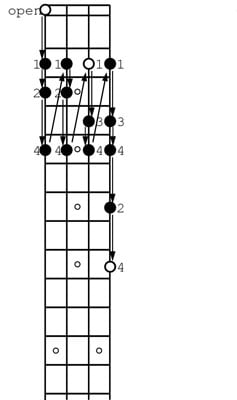Because of the size of the bass guitar, you need to shift your left hand out of position in order to play two-octave scales. The two-octave E minor scale is the only minor scale that requires a different pattern, but it also requires only one shift. This position can be found at the low end of the neck near the nut. (If you have trouble identifying the nut, remember it doesn’t have a shell.)
To shift your hand smoothly, you need to anticipate where your hand will be for the next several notes (not just for the next note) so that your musical phrase or scale can flow smoothly even though your hand is making a shift.
Review the structure of the two-octave E-minor scale.

This is the unique structure of the two-octave E-minor scale. Be sure to refer back to this structure while you’re playing. (If you happen to be a lefty, please read “right hand” to mean “left hand,” and vice versa.)
Strike the open (unfretted) E string with your right hand.
You don’t have to press the string down to play the root (the first note of the scale) — just strike it.
Press the index finger of your left hand down on the second fret of the E string and strike the string with your right hand.
Stay in position and on the same string to play the next two notes.
Fret with your middle finger and then your pinkie, striking the E string with your right hand as you fret each note.
Stay in position, but move the index finger of your left hand to the A string; then play the next three notes.
Press (in order) the frets under your index finger, middle finger, and pinkie, striking the A string with your right hand for each note.
Stay in position and move the index finger of your left hand to the D string for the next three notes.
Press down with your index finger, then your ring finger (not, as before, with your middle finger), and then your pinkie, striking the D string as you fret each note.
The note that you played first, with your index finger, is one octave above your original root note. If you want to play only one octave of E minor, you can stop after that first note.
Stay in position and move the index finger of your left hand to the G string for the next three notes.
Like you just did on the D string, frets with your index finger, ring finger, and pinkie, in that order.
Keep your eyes on the fret that you just played with your pinkie. The next note, which is played with your middle finger, is two frets above the last note, so your hand has to move four frets in order to get your middle finger on the right fret (as described in the next step).
Shift your left hand four frets up along the G string, placing your middle finger two frets above the previous note played by your pinkie, and finish the scale.
Fret with your middle finger and strike the string with your right hand. Then fret with your pinkie and strike the string. You've made it to the top!

